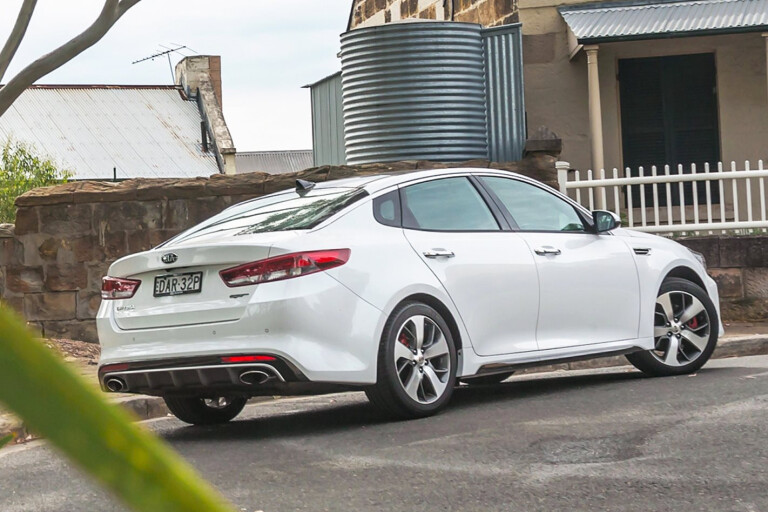
COULD I be happy with a highly equipped – and I mean loaded – Korean car? It’s something I’ve long wondered, yet I always thought I knew the answer (erm, no).
But along the way things have changed. First of all, today’s Korean car is a generally far more solid, much better handling machine that those of a decade ago. I’ve changed too. With kids, I’ve slowed down a bit, and living in Sydney’s inner ring means I now prioritise comfort and conveniences; dynamics don’t matter so much when the road is inevitably a car park.
However, I can only take this view because I not only have the luxury of a dedicated daily driver – the Kia Optima – but also a pair of cheap, lightweight, once-were-performance cars for relief. To put it another way, if I only had one car, well, it would have to have a manual gearbox to keep me sane for starters (which, in the Optima, isn’t even an option).
To recap the history of the Optima briefly, the model got relatively sexy in the 2010 transition from the second to third generation (with the arrival of a new design chief, former Audi man Peter Schreyer), but it still had little in the way of engine or dynamic appeal. This new fourth-gen model brings a GT option with turbo torque and more polished dynamics, but doesn’t look quite as sharp.
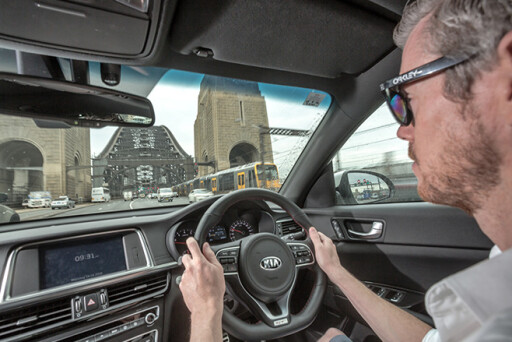 A two-tiered line-up provides an appliance and a warm sedan. The $34,490Si is pitched against up-spec Camry variants, with either an internal combustion engine or a hybrid set-up. Equally as exciting as the Toyota, the Si is nonetheless very well equipped, with more than double the warranty.
A two-tiered line-up provides an appliance and a warm sedan. The $34,490Si is pitched against up-spec Camry variants, with either an internal combustion engine or a hybrid set-up. Equally as exciting as the Toyota, the Si is nonetheless very well equipped, with more than double the warranty.
Then there’s the GT you see here. At $43,990 – almost 10 grand more than the Si – it feels kinda pricey; you can have any Passat you like for less than $50K, for example.
A 2.0-litre turbo engine endows it with 180kW and 350Nm, sent to the front wheels via a six-speed automatic, and marks a big grunt improvement over the atmo 2.4-litre petrol four in the Si (and previous-gen Optimas). But those outputs aren’t nearly as effective in a 1605kg sedan as they would be in something 200kg lighter (say, a Skoda Octavia RS).
Aurally, the engine doesn’t inspire, which it probably should, at least a bit, in the context of the (seemingly misplaced) GT badge. And, not unexpectedly, it’s seems a bit thirsty in urban driving.
The Optima steers surprisingly heavily – and that’s before you press the system into Sport mode – and the ride is firm, though not uncomfortable. The handling, meanwhile, is better than the old one, and the current-gen Si.
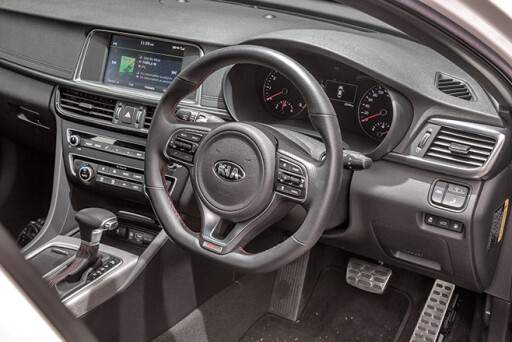 I’m more sold on the cabin space, build and equipment. The Optima is quiet, feels solid and is roomy in the back, and the ventilated front seats, pull-up mesh rear window blinds, reversing camera with dynamic guidelines, and intuitive infotainment and navigation systems are proving useful. However, I’ve already caught out both the autonomous emergency braking and blind-spot indicator systems without trying.
I’m more sold on the cabin space, build and equipment. The Optima is quiet, feels solid and is roomy in the back, and the ventilated front seats, pull-up mesh rear window blinds, reversing camera with dynamic guidelines, and intuitive infotainment and navigation systems are proving useful. However, I’ve already caught out both the autonomous emergency braking and blind-spot indicator systems without trying.
I’m quick to direct friends towards a new Kia because, if they’re happy with the way it drives – which is pretty well if the Optima is any guide – the rest of the package is full of positives; solid build, attractive styling, well-finished cabins, high equipment levels and, not least, a seven-year warranty.
But would I buy one myself? I’ll be a lot closer to knowing the answer at the end of six months with the Optima GT.
Eyebrow-raising fuel consumption
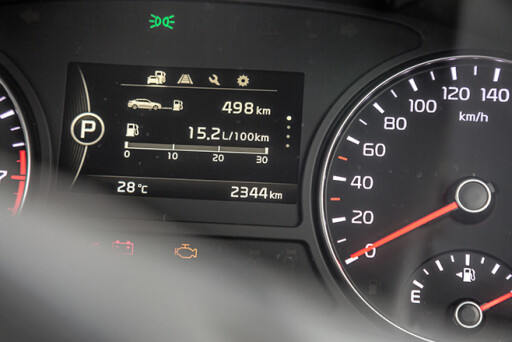 You may not have noticed, but since Dieselgate every time I’ve used the word ‘official’ in the description of fuel consumption test results, it’s carried the implication of a raised eyebrow. The GT’s 8.3L/100km official combined-cycle figure looks good compared with a turbo-petrol Volkswagen with similar outputs and weight (and, for all their woes, VW builds efficient engines), but in my urban reality, it’s been closer to 15.0L/100km so far (which really should be compared with the 12.5L/100km official urban figure).
You may not have noticed, but since Dieselgate every time I’ve used the word ‘official’ in the description of fuel consumption test results, it’s carried the implication of a raised eyebrow. The GT’s 8.3L/100km official combined-cycle figure looks good compared with a turbo-petrol Volkswagen with similar outputs and weight (and, for all their woes, VW builds efficient engines), but in my urban reality, it’s been closer to 15.0L/100km so far (which really should be compared with the 12.5L/100km official urban figure).
Update #2
EASTER brought the opportunity to use the Optima in the way that its GT badge and spacious rear seat suggest it is intended – as a family tourer.
The decision to take the Kia to Nan’s in Katoomba instead of our family wagon, a 2004 Subaru Liberty GT, was pretty easy. The Subaru is none too economical, even on the highway, and with 165,000km on the clock it doesn’t ride brilliantly – even, annoyingly, after I had four new dampers fitted last year. I had little doubt the Kia would be more economical and comfortable.
Being a wagon, the Subaru has more cargo space, and it’s more easily accessible, but this trip would provide a good test for the Kia’s boot. I think the Liberty is marginally more fun, but that wouldn’t be a factor on a double-demerits weekend. Putting the Optima to the obligatory wife-and-kids test would be more interesting.
 Preparing to head off, the 510-litre boot swallowed everything we needed to take, and there was plenty. Inbuilt top tether hooks made it easy to install Grace’s booster and Lucy’s child seat, and the roll-up mesh window shades would prove to be handy, as would the centre armrest (with twin cupholders) for holding toys and things.
Preparing to head off, the 510-litre boot swallowed everything we needed to take, and there was plenty. Inbuilt top tether hooks made it easy to install Grace’s booster and Lucy’s child seat, and the roll-up mesh window shades would prove to be handy, as would the centre armrest (with twin cupholders) for holding toys and things.
Five minutes of fiddling with preferences paid off and for 100km there was peace, with no complaints from the girls. Even when little Lucy cracked it, the problem was not Kia-related. We were supplying snacks, just not of the required quality or quantity, apparently. A stop to play at a park and a chocolate egg fixed it.
On resumption, as the trip computer fuel average continued to tumble from urban highs near 15L/100km, I was enjoying the drive. The GT rides with the expected level of comfort and shuts out tyre and suspension noise well, though the density of holiday-goers on the road limited any assessment of the dynamics or the engine’s upper reaches.
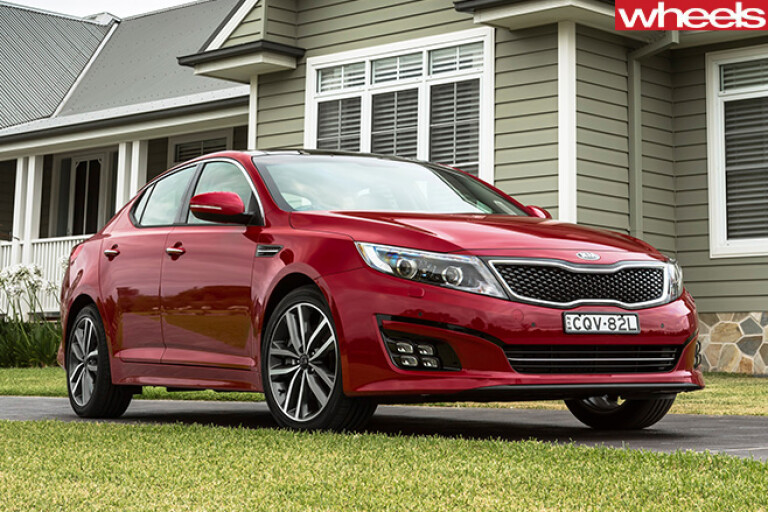
The Kia’s various driver assistance systems work largely unobtrusively, other than the radar cruise control. While doing as it should and reducing speed to maintain the gap to the car ahead, I actually wanted to overtake a L-plater doing 80km/h, not slot in behind him. And I could have done without automatic braking when I knew the car ahead was about to exit the motorway, but the system didn’t.
Doing the reverse trip with a full tank and five up (Nan joined us) sealed the Kia’s credentials as a decent and efficient family tourer, with country figures in the high fives; the old Liberty would be in the sevens.
Update #3
DRIVING a long-termer might seem at odds with the motoring journo’s job of testing lots of models, but it’s the other cars I drive that give me a better perspective on the Kia.
A recent run of hot-rodded German, Japanese and local medium/large sedans contributed to this month’s low kay-count. And the halving of torque from 700Nm (Mercedes-AMG C63 S) to the Optima’s 350Nm, with the simultaneous loss of premo-Euro interior finish, would surely be quite a come-down.
Turns out it wasn’t too bad, though. Given a slight adjustment in expectations to account for the fact the Kia costs less than a third of the Benz, the cabin only offended one out of five senses (though I didn’t lick anything – see breakout). And the Kia’s ride was certainly more forgiving.
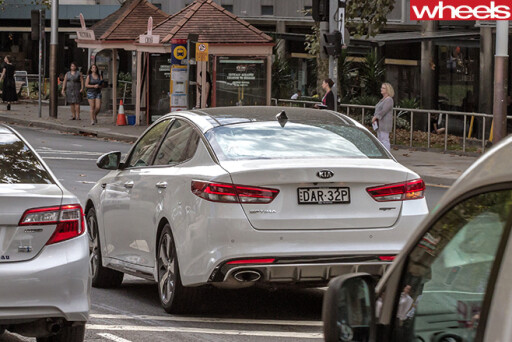 Meanwhile, neither the Benz nor the BMW M3 I had for a while made my drive home much more exciting. By the time I wound up the BMW’s twin-turbo six, it started to feel antisocial and dangerous, so I ended up in nana mode while getting mildly annoyed by the low-speed ride and shunty dual-clutch gearbox. The C63’s burble made the compromises worth it, of course, and they’re both must-drive thrillers on the open road.
Meanwhile, neither the Benz nor the BMW M3 I had for a while made my drive home much more exciting. By the time I wound up the BMW’s twin-turbo six, it started to feel antisocial and dangerous, so I ended up in nana mode while getting mildly annoyed by the low-speed ride and shunty dual-clutch gearbox. The C63’s burble made the compromises worth it, of course, and they’re both must-drive thrillers on the open road.
By comparison, the Kia benefits from a torque-converter automatic transmission and not having to overcome the inertia of a beefy engine and drivetrain; it fairly whizzed up to speed in the urban rush-hour zone. It hadn’t occurred to me that the 1600kg Korean sedan is actually quite lively until back-to-backing with the Germans.
I can’t help but take my old Subaru WRX to the office at least once a week. It’s desperately lacking in active and passive safety – I’ve almost backed into cars when reverse parking because I half-expect to hear warning beeps – but it frequently demonstrates how much less fun cars have become. The low-speed engine NVH is woeful, but the glaring lack of refinement comes in a reasonable trade-off for the unfailing involvement. Hey, I want to drive, not go along for the ride.
 I guess some buyers do just want to be an occupant and on that front, if you’ve not experienced one for a while, you might be surprised how vault-like a modern Kia is. The Optima’s doors are heavy, the body feels drum-tight over bumps, which are ridden pretty well, and it’s quiet.
I guess some buyers do just want to be an occupant and on that front, if you’ve not experienced one for a while, you might be surprised how vault-like a modern Kia is. The Optima’s doors are heavy, the body feels drum-tight over bumps, which are ridden pretty well, and it’s quiet.
By comparison with everything I’ve driven lately, the kids seem miles away from me in the back seat, and a big, solid car is exactly what I want for family duty.
The flipside is that I feel I’m shoehorning the Optima through the urban rat-run I blitz regularly in the Rex – the Optima is about the same size as a VZ Commodore, while the tinny, tiny Subie is smaller than a VB.
Update #4
CHANGES of environment proved revelatory this month. I jumped into an Optima Si for the first time, and spent a couple of weeks in it while my GT was thrown into a Wheels mid-size megatest.
Stepping from GT to Si spec is officially a downgrade, but I was much happier in the ‘base’ Optima than I expected to be. The two-tiered line-up means the Si isn’t a base model in the sense of basic equipment level. At $34,490, it’s mid-spec Camry money, and this is a Korean after all so I shouldn’t have been surprised to discover how much gear it has.
I appreciated still having a reversing camera, front and rear parking sensors, dusk-sensing headlights, rain-sensing wipers and sat-nav. And it’s nice to know that autonomous emergency braking, automatic high-beam headlights and a tyre-pressure monitor are still part of the deal.
The Si is a decidedly conservative-looking package, and the first suggestions that this is no flagship are the lack of a smart key and start button. That said, I think the steering column barrel still makes a logical place to slot your key.
You also lose the GT’s Harman Kardon audio, powered driver’s seat and sunroof, as well as the blind-spot detection, lane-change assist and rear cross-traffic alert systems, but that’s fair enough.
 Finally, there are no heated and ventilated seats, but I think they’re less necessary with cloth trim than leather. And I like cloth seats because you don’t slip around on them in corners, though they’re not as kid-friendly as leather.
Finally, there are no heated and ventilated seats, but I think they’re less necessary with cloth trim than leather. And I like cloth seats because you don’t slip around on them in corners, though they’re not as kid-friendly as leather.
The Si’s steering wheel doesn’t feel cheap or anorexic, and there are still paddle shifters, which is great. The column-mounted electric motor-assisted power steering detracts from feel, which isn’t a GT strong suit anyway, while the transition to mainstream 215/55R17 tyres from the GT’s adhesive 235/45R18 Michelin Pilot Sport 3s adds to ride comfort and removes very little in the ’burbs.
The Si, which at 1585kg weighs about 65kg less than the GT, gets different gear ratios from first through to fourth (they’re slightly taller) and the 241Nm atmo 2.4-litre four has enough low-rev torque that it goes just as well as the 2.0 turbo GT in the city. Both have enough for the job, yet neither tickles the senses.
While the megatest’s results will be revealed in a forthcoming issue, suffice to say that when the Kia Optima GT is put on some of NSW’s best country roads, where it’s possible to give it a hustle, well… let’s just say it becomes a very different machine to the one I know.
Farewell
BACK when I had my first car, I waged war on unnecessary equipment. As a 19-year-old in a Mazda RX-7 of the same age, these included the jack, spare wheel and washer bottle. This made it a stripped-out, race-ready special, you see.
Part of that personal philosophy has always stayed with me. The average modern car, by my purist’s rationale, is chock full of flagrantly useless crap. While I wasn’t about to rip out the Optima GT’s heated front seats or steering wheel or blind-spot monitor, I vowed never to use such weight-adding, performance-sapping luxuries designed for people lacking my resolve and skill.
But I’ve been infected by the insidious disease that is the convenience feature. “The heaters are already there, contributing to the Kia’s 1605kg kerb weight, Jimmy,” went my subconscious. “Go on, indulge!”
 So in the middle of winter, early one freezing morning, I hit the buttons for the heated seats and the toasted tiller. And it was quite nice. Now I use them all the time, and it makes me warm, comfortable… and a sell-out.
So in the middle of winter, early one freezing morning, I hit the buttons for the heated seats and the toasted tiller. And it was quite nice. Now I use them all the time, and it makes me warm, comfortable… and a sell-out.
It turns out that the headline features – the ones in my mind are where modern cars have given up and gotten fat – are the ones I’ve started to like the most. But there are still others that reaffirm my hardcore stance on excess stuff.
While reversing the Kia Optima into my driveway the other day, I pressed the button to disable the parking sensors so as not to wake my daughter sleeping in the back. Then the phone rang, so I reached to bar the call on the multimedia screen, only to discover that the reversing camera display meant I couldn’t do this. I slotted the gearbox into drive to exit the reversing camera screen (I could’ve pressed the button on the wheel, but the pressure of keeping her ladyship asleep removed the possibility of quick, logical thought), barred the call, then slotted back into reverse. At which point the parking sensors started their merry beeping...
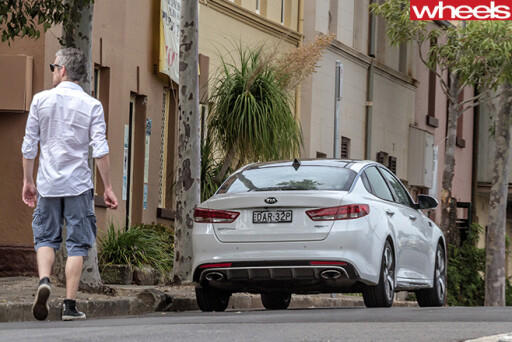 Finally, once parked, I inadvertently restarted the car (I pressed the start button only intending to enliven the cabin electrics to close a power window that had been left open) and the radio comes back on at a pre-set volume, even though I’d been driving with it muted.
Finally, once parked, I inadvertently restarted the car (I pressed the start button only intending to enliven the cabin electrics to close a power window that had been left open) and the radio comes back on at a pre-set volume, even though I’d been driving with it muted.
Thankfully, Little Miss slept through it all, including the cursing and shouting, leaving me to dream up my ideal tarmac-rally Optima RS, which would have no spare, washer bottle or equipment… but I’ll keep the heated steering wheel and driver’s seat.

COMMENTS